
By James Brewer
Make Art not War, declares one of the first ‘canvases’ (in fact it is a piece of recycled timber) that we encounter at the Royal Academy Summer Exhibition for 2023, the message for the epoch standing out in bold signwriter enamel paint.
From then on, the visitor can wander for hours, should the mood take them (and it very likely will) around this massive spectacle, thanks to the 11,204 people who sent in a total of 16,500 submissions to be judged digitally, and who took up that ‘make art’ mantra with a will. The total was whittled down, one might say, to the still huge number of 1,614 artworks. There is plenty to exclaim over, in every imaginable technique.
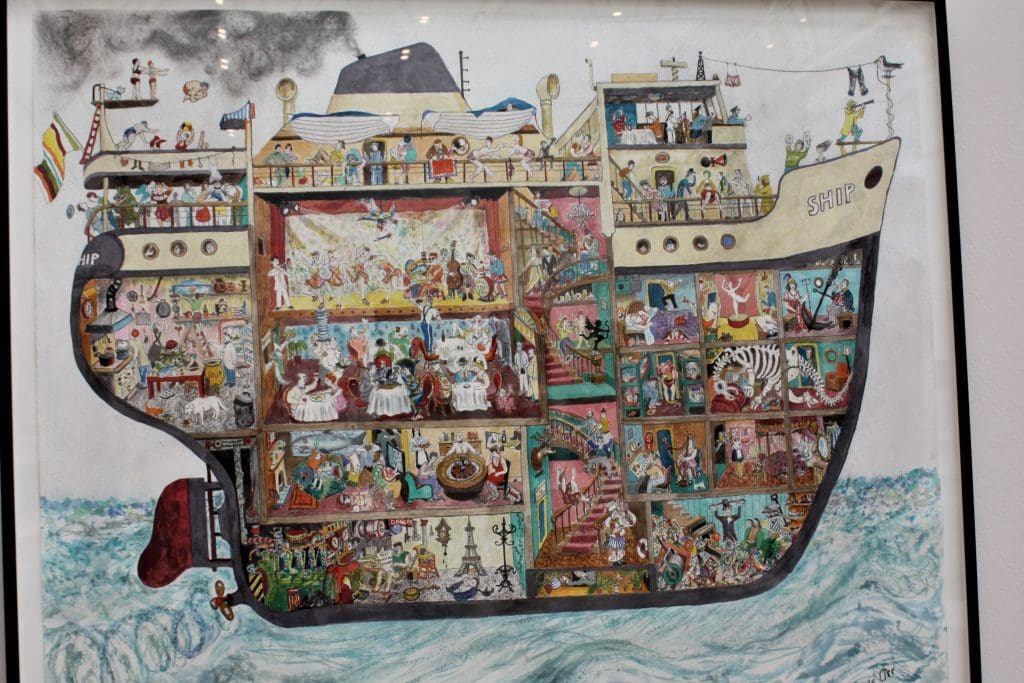
Most of the artists avoid intruding into global conflict, as though heeding the exhortation of the author of Make Art Not War. There is within this grand exercise though a tongue-in-cheek warning (from satirical illustrator Chris Orr) that society is a “ship of fools” as envisaged by the Greek philosopher Plato, not heading for a Titanic iceberg, but in danger of internal strife and meltdown.
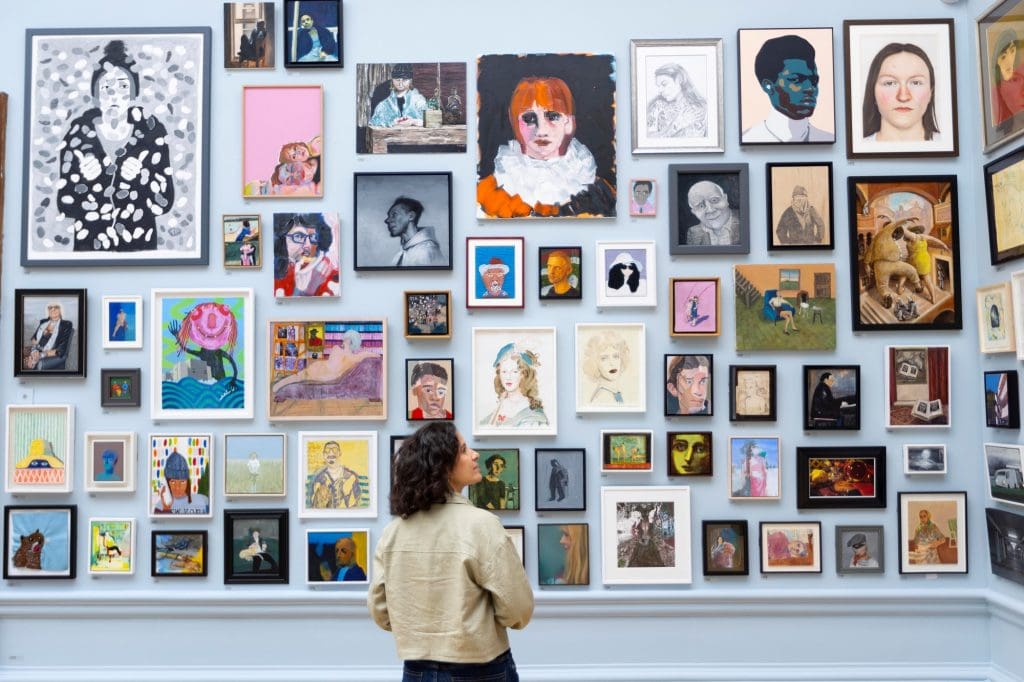
The 255th summer exhibition, open until August 20, 2023, is a bravura account of contemporary art and architecture, a platform and support for artists at all stages of their career. Royal Academicians are entitled to submit up to six works to the annual event – many of them take full advantage of that – and alongside are offerings from people invited by a committee and from external hopefuls – all making for an illuminating immediacy.
Responsible for the lively line-up this time is the painter David Remfry who, dressed in his habitual black fedora and black suit, stood alongside RA secretary and chief executive Axel Rüger to open proceedings. Remfry proposed the theme Only Connect, inspired by lines from the 1910 novel Howards End by the humanist author EM Forster. Forster was disturbed by society’s intensifying relationship with the advance of machines, a concern echoing more than a century later. In the book, a leading female character counsels: “Only connect! That was her whole sermon. Only connect the prose and the passion, and both will be exalted, and human love will be seen at its height.” Interviewed for the RA magazine, Remfry adds his plea for societal empathy, lamenting: “We have unprecedented ability to communicate, and we’re further away from one another than ever.”

Royal Academician Bob and Roberta Smith who in 2017 received an OBE for services to the arts, is a regular at RA summer shows and has four entries in the 2023 show, insisting governments must prioritise the arts. Bob and Roberta Smith is the double pseudonym of Patrick Brill, who says that his father, a World War II veteran and artist, told him from his deathbed: “Make art, not war. Don’t hate, draw.” This, the current work Make Art not War, employing the traditions of signwriting, and using cast-off materials. The pseudonym derives from Brill combining the name of his sister Roberta with Bob and Smith, two names common in the UK, to create what he says is a more egalitarian platform.

The summer exhibition always pays tribute to artists who have passed away in the preceding 12 months. This time, these included Dame Paula Rego. Her stark hand-coloured etchings, Refugees I and Refugees II (displayed courtesy of Cristea Roberts Gallery) with a mother cradling her son against a background of shattered bodies, are a reminder that the artist’s life was shadowed by the plight of refugees. She was born in Lisbon in 1935 at a time when Portugal was a dictatorship and oppositionists were persecuted and imprisoned or obliged to go into exile. After the Second World War, German refugees appeared in Estoril, a resort near Lisbon, looking for work; and Paula too started a new life overseas, moving in 1951 to London where she married a fellow artist, Victor Willing.
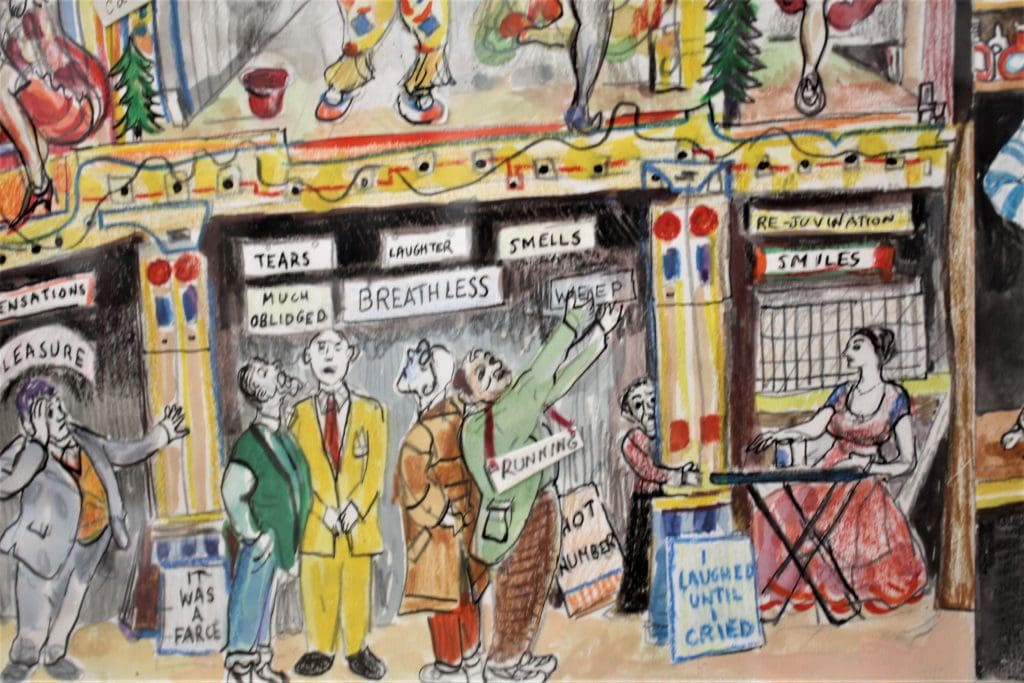
Her fearless depictions and her activism – she campaigned for abortion rights in Portugal and elsewhere – are embraced pictorially in strong feminist themes as she remonstrates against male abuse and oppression. Her dramatic installation entitled Oratorio (courtesy of Ostrich Arts Ltd and Victoria Miro) dates from 2008-09. In a large wooden cabinet in the form of an altarpiece she places eight pastel, conté crayon and charcoal drawings and eight figures in panels. Dolls represent characters from fables, nursery rhymes, films, and news items. The tableau is of horrifying scenes including a woman wielding a knife to stop herself from being raped and the nightmare of giving birth under extreme conditions.
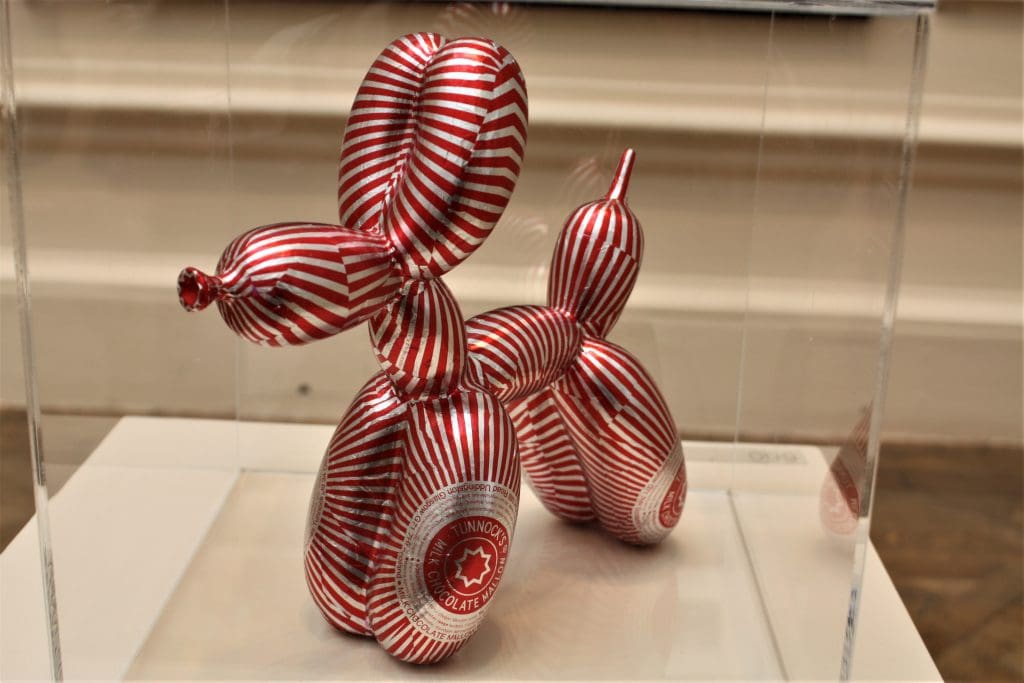
Landscapist, the late Frederick Cuming, paid homage to the enduring techniques of colour and atmosphere that had burst on the scene from masters such as JMW Turner, Pierre Bonnard, Henri Matisse and Paul Nash. The summer exhibition has a beautiful example of his vision of the natural world, an oil entitled Low Tide Reflections. Born in 1930, Cuming was still painting during the week he died at his home near the Sussex town of Rye. He was a long-standing favourite of the RA – he had been the featured artist in the 2001 summer exhibition with an entire gallery dedicated to his work.
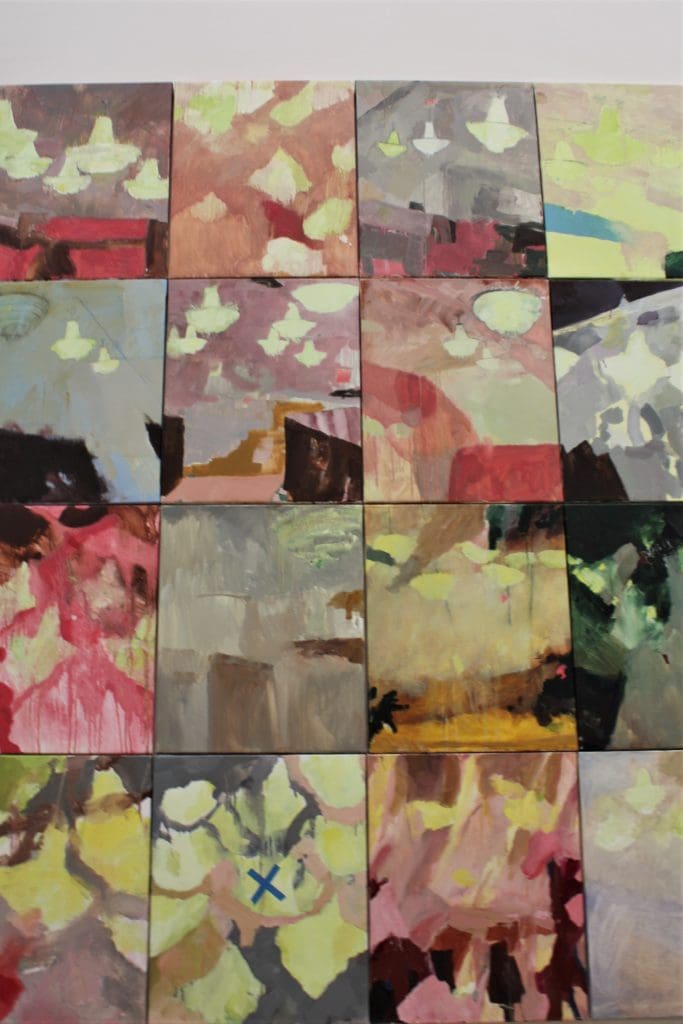
Injecting into the free-for-all much finely detailed satire, Londoner Chris Orr has three paintings and three prints on the walls. The modestly titledShip is in watercolour and mixed media on paper and confirms his career-long interest in boats and ships. His style has been described as a Hogarthian commentary on contemporary society. He uses expansive cut-away drawings which were influenced by the double page spreads explaining the inner workings of ships, trains and aeroplanes, as popularised in the 1950s and 60s by the Eagle comic. Orr says his new work owes something to Plato’s Ship of State and allegorical Ship of Fools as in Book VI of the Greek philosopher’s Republic. The state is like a vessel that can be wisely or unwisely captained. “Unlike the Titanic, my Ship is not heading for the iceberg, but is much more likely to come a cropper from internal strife and meltdown,” he has written on websites. He recalls that his diploma work for the Royal Academy in 1995 was an etching entitled The small Titanic.
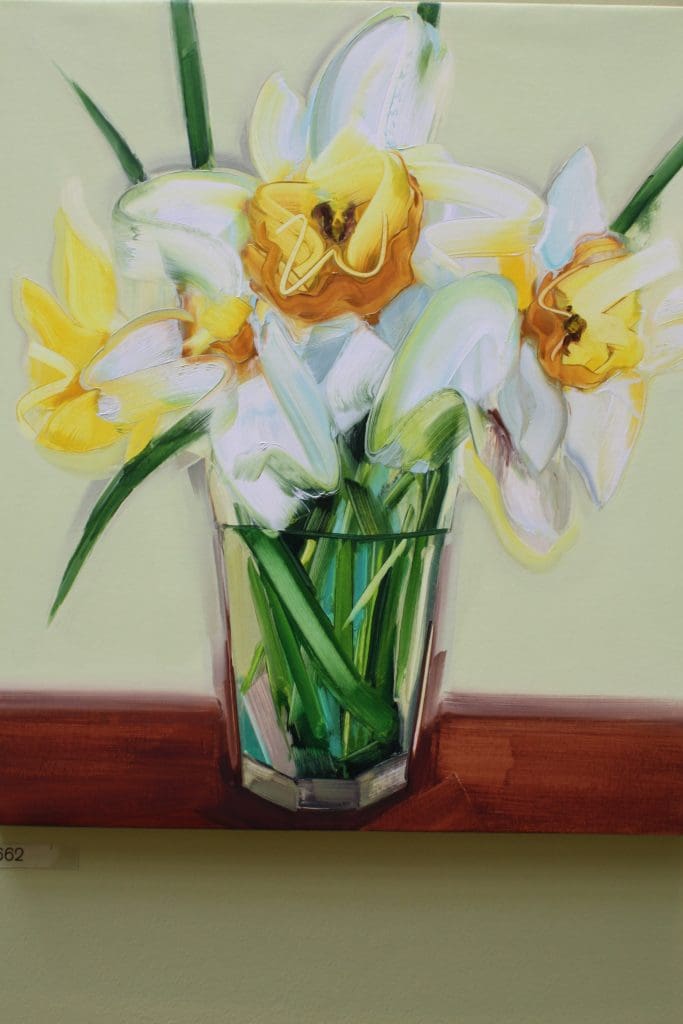
In similar style, Orr’s Theatre of the Absurd echoes the follies in the theatre of life. When he encountered the Theatre of the Absurd as practised by the playwright Eugène Ionesco, the artist “took to it like a duck to water.” Orr’s current offering grew out of drawings he made after watching the comedian Ken Dodd in one of his four-hour stand-up performances. “Ken is not in the picture, but his spirit is.”
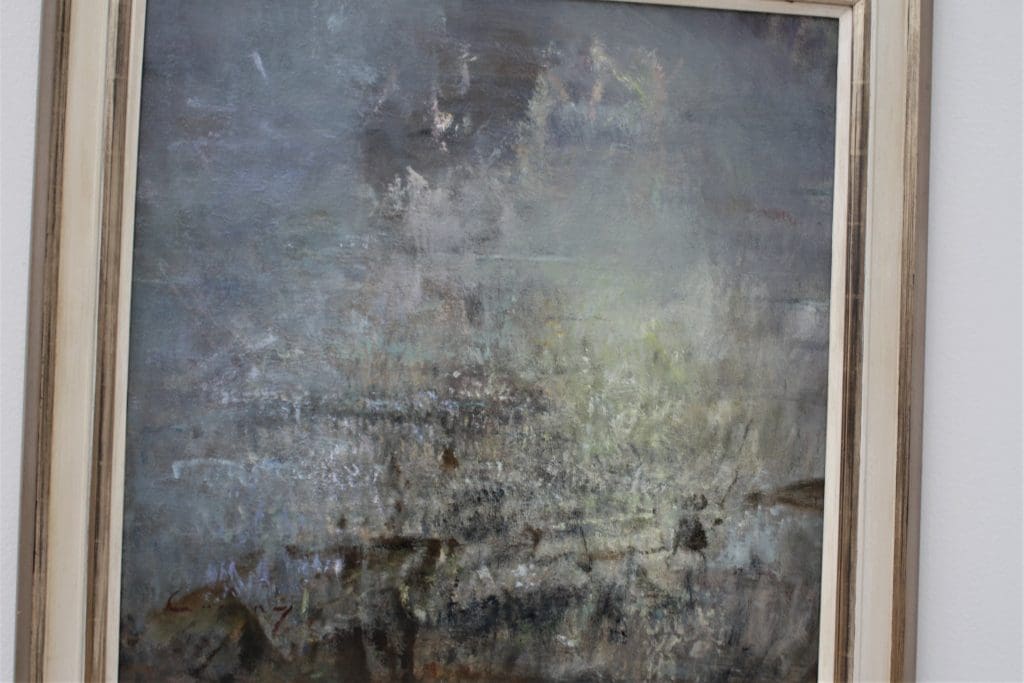
Directly addressing the theme Only Connect is Handshake, an oil painting by London-based Trevor Burgess. It is of a fleeting but spontaneous gesture he skilfully captured after walking through Deptford market in southeast London. For many years Burgess has been fascinated by the urban environment, especially London market stalls and shops, painting commonplace scenes such as crowded pavements and people crossing the road. He has recorded markets in other European countries, Latin America, and India. The subject formed the core of his work at a solo exhibition, The Market Paintings, at the Menier Gallery in London in 2016, and an exhibition of 18 of his paintings of Fruits and Vegetables was recently at Galerie W|O|S in Zurich.
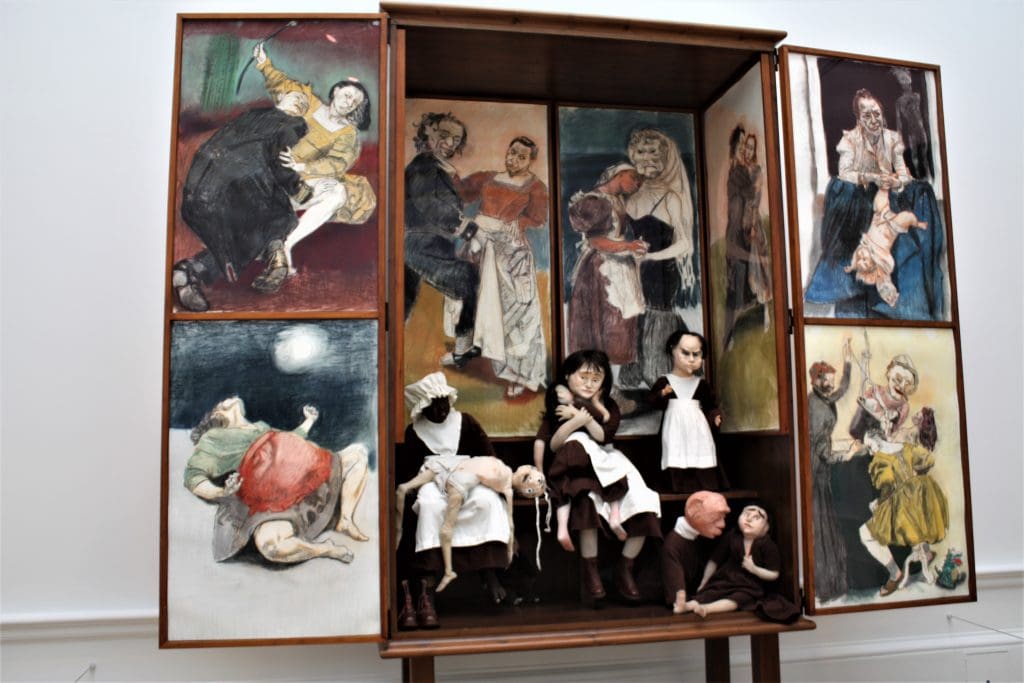
Scottish brothers David and Robert Mach make separate appearances at the exhibition with highly original and memorable contributions. Anarchy in the UK is a startling piece of sculpture by David, who fashioned from push pins, wood and foam a caricature of a regal head – of the late Queen? – wearing a sumptuous crown yet sporting on her neck a tattooed anarchist symbol. It is typical of his penchant for small, inexpensive everyday materials for soft sculptures and collages. In his time, he has used some hefty materials too – such as the 185,000 bricks he asked a huge team of bricklayers to lay as a 29 m long, 7 m high sculpture called Train on the outskirts of Darlington, celebrating that town’s railway heritage. On another occasion, he manoeuvred 12 disused red telephone boxes so that they looked like falling dominoes, for a 1989 project Out of Order, a town centre installation commissioned by the Royal Borough of Kingston upon Thames.
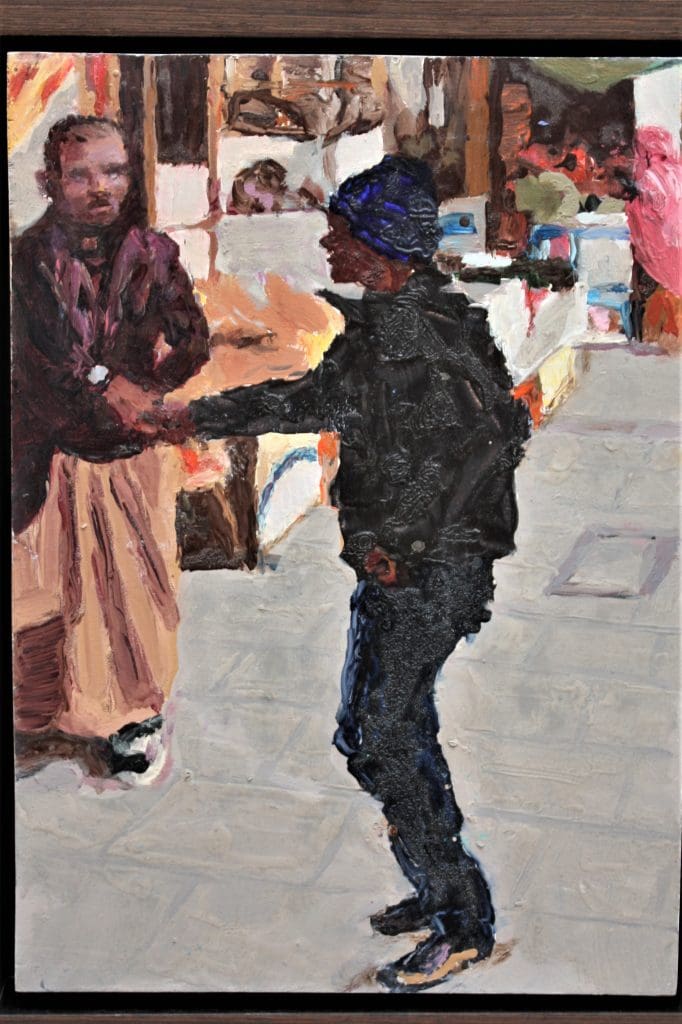
Robert Mach has worked for more than 30 years with his brother on sculpture, installation, and collage, organising exhibitions while producing his own artwork. He has works in the collections of Walter Scott & Partners in Edinburgh and public corporations. Robert has what is probably the most delicate artefact in the entire summer exhibition. It is an ingenious imitation in miniature of the balloon dogs of Jeff Koons: Robert has wrapped his sculpted ‘dog’ in brightly coloured foil from a Tunnock’s teacake, a marshmallow product “made in Scotland since 1890.” He calls the result Tunnocks Redcoat. The medium he describes as “confectionary wrappers on resin in acrylic case” and it comes in an edition of 25 at £1,200 each.
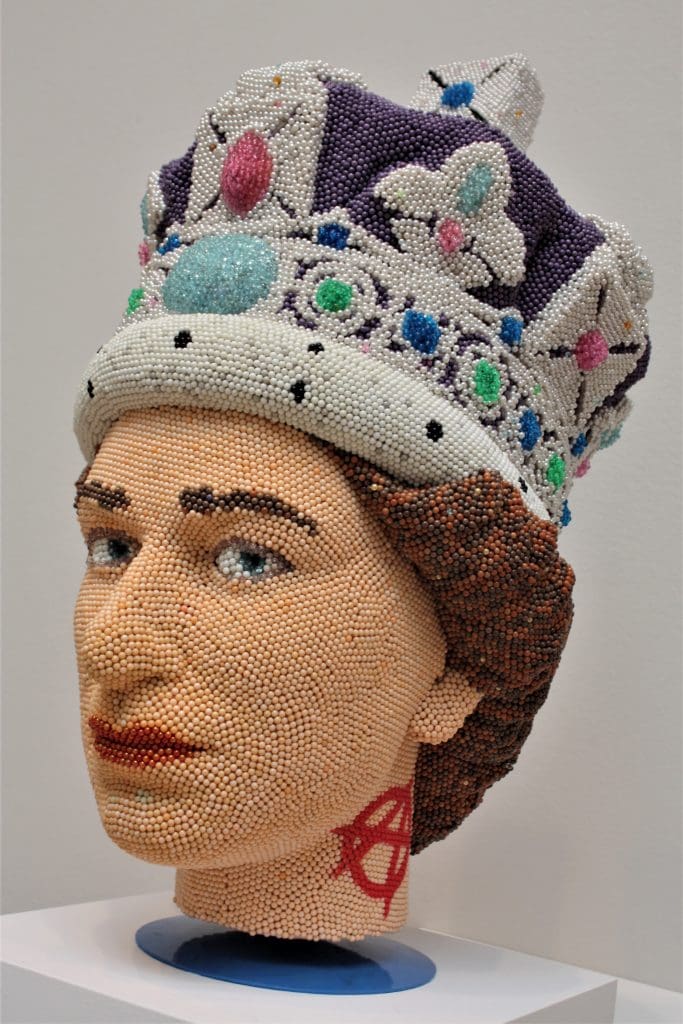
David Remfry, known for his substantial watercolours, has a large new work on show which he calls Indoor Cosmology. It is a group of 16 oil paintings, each showing the blazing colours of chandeliers viewed from below. He says that the inspiration was the green glass lighting of the social club and hotel Soho House, New York. The American metropolis has been of enormous importance to the artist, now aged 80, and many of his works show landscapes and portraits of residents and friends made while living and working from the city’s Hotel Chelsea, which had a clientele of numerous famed artists, writers and musicians and was dubbed by the playwright Arthur Miller “the high spot of the surreal.”
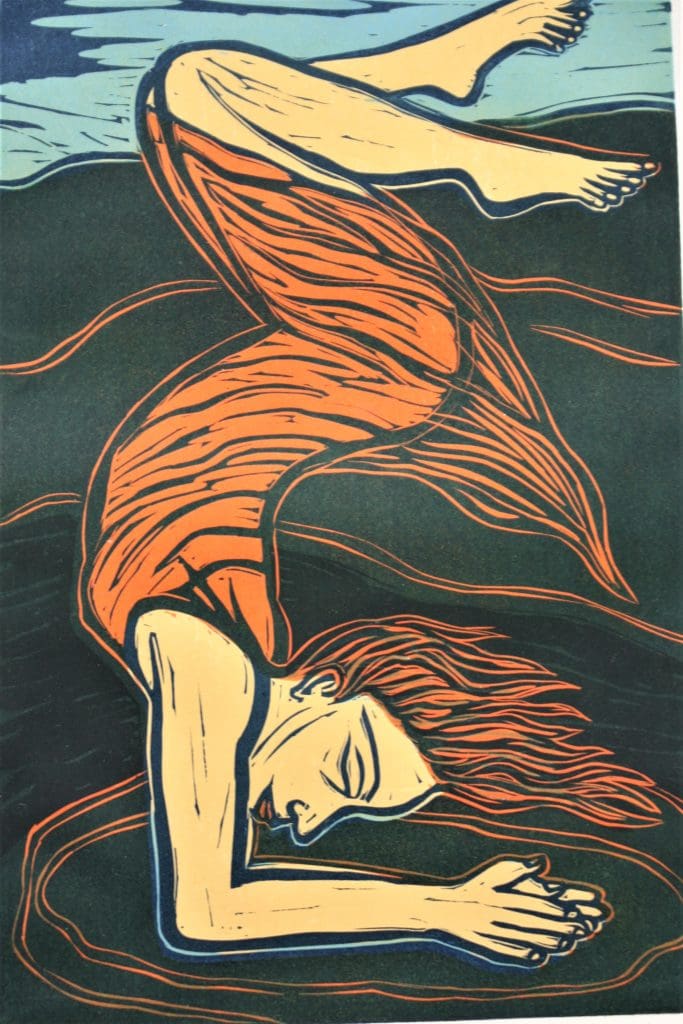
The unassuming In between days is one of the more figurative works from London-based Nicholas McLeod, whose website quotes him thus: “Although my work could be characterised within the genre of still life, the paintings are not necessarily about the objects they depict. Instead, these motifs enable me to explore an obsessive relationship with paint; with the way in which it behaves, moves and registers.”
Safe Haven is one of six entries in the show from RA stalwart Eileen Cooper who is oriented towards projecting the female experience. Linocuts are greatly suited to her bold, lyrical, and emphatic style.
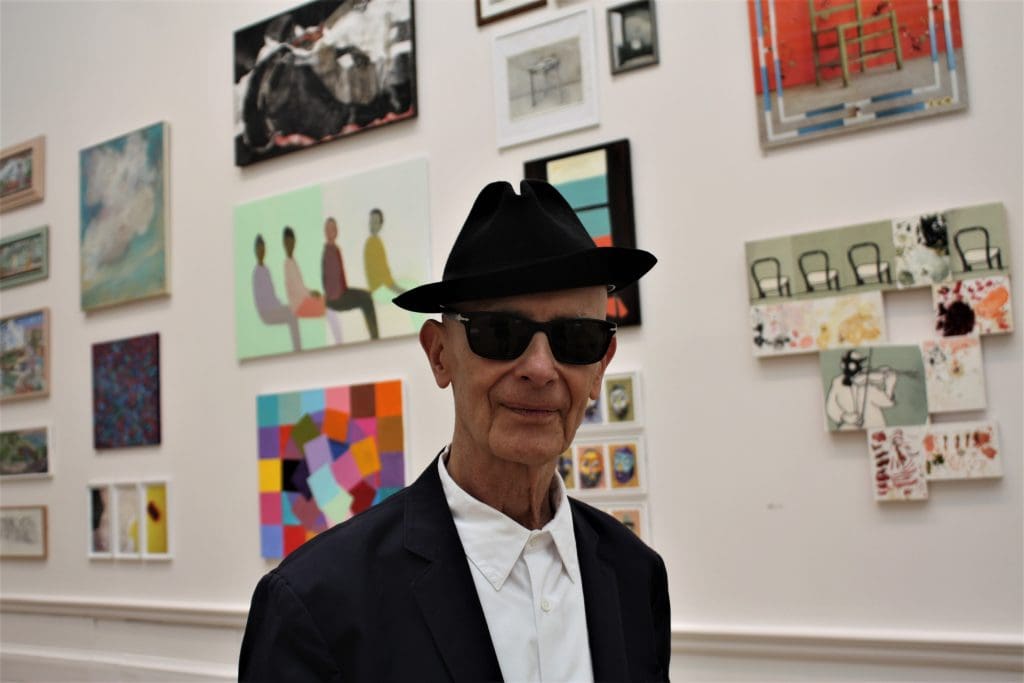
Many of the exhibitors have not necessarily followed the theme of Only Connect – among the entries are an oil painting by Jamie Lloyd entitled Toilet Rolls. That is available to buy, at £5,000. Meanwhile, Creased stripey T-shirt, oil on linen (linen you might have guessed is the medium) by Hannah Knox, can be purchased for £2,400.
Ryan Gander’s Rest in Pieces from his series The Squatters is a computer-controlled ‘stuffed cat.’ His battery-powered sculptures of cats, with realistic fur and bellies which move as though they are breathing, are part of a practice ranging from sculpture and performance to film, writing and graphic design. He seeks to make people question what they see, and for Manchester International Festival, he has a conceptual contribution running until July 16, 2023, entitled Find. The Chester-born artist who studied at Manchester Metropolitan University is challenging people to hunt for thousands of coins he has left on park benches, in food courts and libraries, and tucked between tram seats. Each coin, he says, is a collectible artwork engraved with words of wisdom “designed to guide its owner in any decision-making process.”
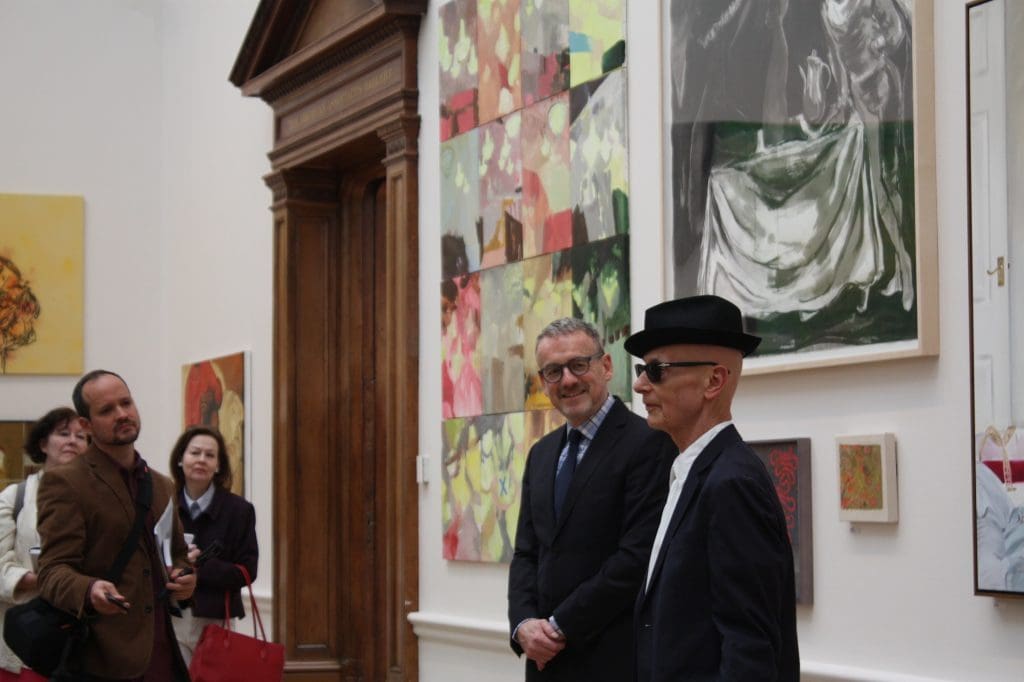
A panel of judges awarded the prize for the most distinguished work in the exhibition to the American artist Kara Walker, an honorary Royal Academician known for her stark silhouette oeuvre. She receives the Royal Academy of Arts £25,000 Charles Wollaston Award, one of the most significant art prizes in the UK, for The Omicron Variations: the judges said that the drawing in ink on paper traces “the historical lineages of oppression and subjugation across centuries and continents; her work questions and confronts present-day matrices of race, power, and desire in the United States.” Kara is an admirer of, among others, Andy Warhol.
Not to be overlooked is this year’s Architecture Room, curated by Royal Academician Peter Barber, with models, maquettes, drawings, textiles and ceramics on display, including two towering works by the late academician Phyllida Barlow.
Picture captions:
Ship. By Chris Orr. Watercolour and mixed media on paper (detail).
Ship. By Chris Orr.
Installation view of the Summer Exhibition 2023. Photo: © Royal Academy of Arts, London/David Parry.
Make Art not War. By Bob and Roberta Smith. Signwriter enamel on found timber.
Refugees II. hand-coloured etching. The late Dame Paula Rego. Edition of 50.
Theatre of the Absurd. By Chris Orr. Watercolour and mixed media (detail).
Tunnocks Redcoat. By Robert Mach. Confectionary wrappers on resin in acrylic case. Edition of 25 at £1,200. Tunnocks Milk Chocolate Mallow.
Indoor Cosmology. By David Remfry. Oil.
In between days. Oil. By Nicholas McLeod.
Low Tide Reflections. Oil. By the late Frederick Cuming RA.
Oratorio. Wood cabinet with side panels comprising eight paintings (conté pencil on paper) and eight figures. By the late Dame Paula Rego RA.
Handshake. Oil on board. By Trevor Burgess.
Anarchy in the UK. Push pins, wood and foam. By David Mach.
Safe Haven. By Eileen Cooper. Linocut (edition of 40).





